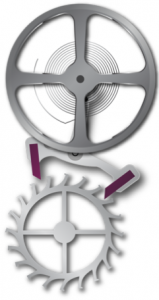From the energy stored in the mainspring of the barrel to the oscillating system regulating the time, the video below perfectly explains in simple terms how a mechanical watch works.
See in detail how the time is regulated by the combined action of the escapement and the oscillating system, the “heart of the watch”, composed of the balance wheel and the hairspring.
Acting just like a brake, the Swiss lever escapement transmits the energy from the mainspring to the balance wheel.
Attached to the hairspring – a tiny spring in spiral shape – is the balance wheel that beats, or oscillates, extremely accurately at a frequency between 5 and 10 times per second*.
Aging, gravity, vibrations, temperature, magnetization, etc., all of these factors can interfere with the regulator organ causing the balance wheel to oscillate slightly faster or slower, which in turn makes the watch run faster or slower. This deviation, called the rate accuracy, is expressed in seconds per day [s/d].
*The range of beating frequencies mentioned above, expressed in Hertz [Hz], is found in the vast majority of watches.
